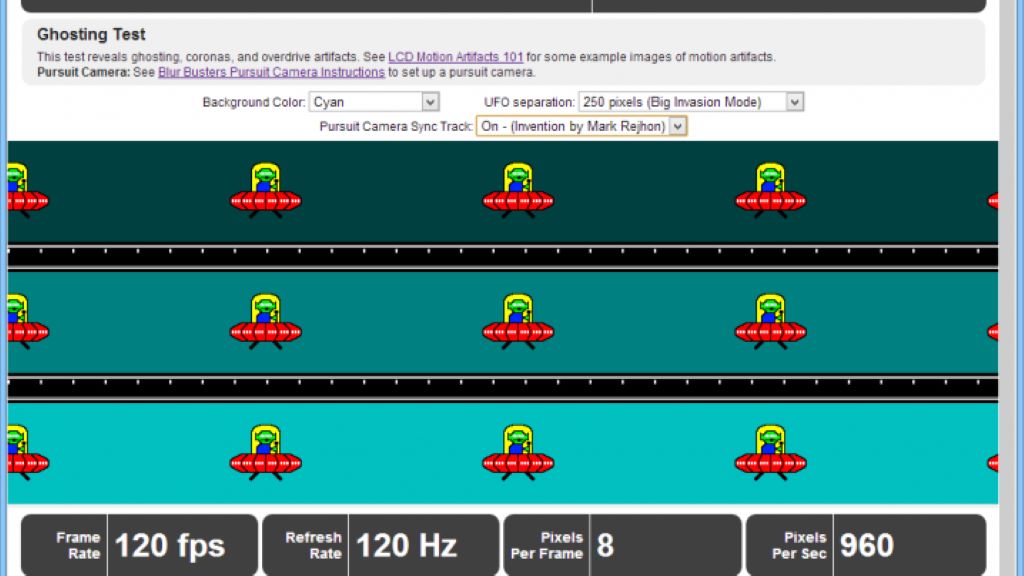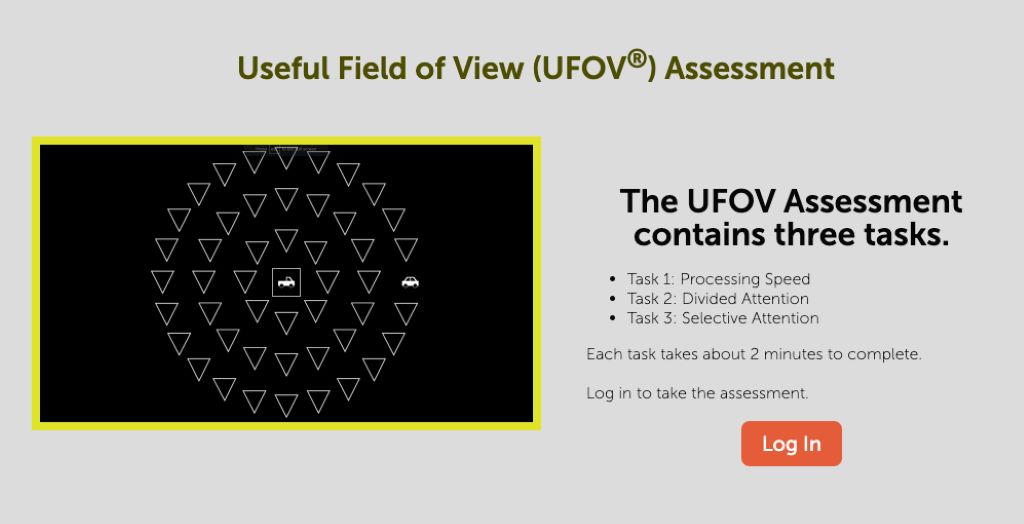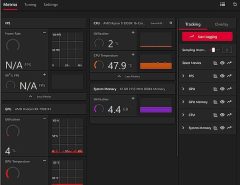The UFO test, also known as the useful field of view (UFOV) test, is a computer-based test used to evaluate a person’s visual processing speed and ability to divide attention. It was originally developed in the 1980s by Dr. Karlene Ball and Dr. Daniel Roenker at the University of Alabama at Birmingham to assess functional vision deficits in older adults. Since then, the UFOV test has become a widely used tool for evaluating driving safety and identifying people at higher risk for automobile crashes.
Overview of the UFOV Test
The UFOV test measures a person’s processing speed, divided attention, and selective attention. It requires individuals to quickly identify and localize visual targets in the central vision and the peripheral visual field. The test gets progressively more difficult by introducing visual distractors and forcing the individual to divide attention between multiple tasks.
The UFOV test is administered on a computer and takes 15-20 minutes to complete. It consists of three increasingly complex subtests that evaluate the following abilities:
Subtest 1: Processing Speed
This subtest measures how quickly a person can identify a centrally presented target. The target is typically a silhouette of a car or truck inside a box. As the test progresses, the presentation time of the target decreases, forcing the individual to respond more rapidly. This subtest evaluates visual processing speed under optimal conditions.
Subtest 2: Divided Attention
In this subtest, the central identification target is presented along with peripheral localization task. The individual must divide their attention between identifying the centrally presented target and localizing a simultaneously presented peripheral target. This subtest evaluates an individual’s ability to distribute attention across a wide field of view.
Subtest 3: Selective Attention
This subtest adds distractors to the divided attention subtest. The person must not only divide their attention between central and peripheral tasks, but also inhibit attention to visual distractors surrounding the targets. This assesses an individual’s ability to maintain attention focus in the presence of distractors.
Performance on all three subtests provides insight into a person’s visual processing speed, divided attention, selective attention, and attentional control. Scores can help identify drivers at increased risk for automobile crashes due to cognitive impairments.
Why Was the UFOV Test Developed?
The UFOV test was originally developed in the 1980s by Dr. Karlene Ball and Dr. Daniel Roenker at the University of Alabama at Birmingham. They aimed to create an objective and standardized test designed to evaluate key visual and cognitive abilities needed for safe driving.
At the time, existing vision tests for older drivers focused primarily on visual acuity. However, research showed that declines in visual acuity and other basic visual functions were poor predictors of crash risk in older adults. Ball and Roenker hypothesized that higher-level visual and cognitive impairments involving speed of processing, divided attention, and attention selectivity may be better predictors of driving safety.
To test this hypothesis, they developed the UFOV, which specifically isolates and measures processing speed, divided attention, and selective attention. Subsequent research validated their hypothesis, showing the UFOV test was a much better predictor of crash risk, especially in older adults, compared to existing vision tests.
Since its inception, the UFOV has become one of the most widely used and thoroughly validated tools for evaluating driving safety and crash risks. It provides objective data to help identify high-risk drivers of all ages who may require additional assessment, training, or driving restrictions.
Administering the UFOV Test
The UFOV test is administered on a computer. The commercially available UFOV software from Visual Awareness, Inc is the most common implementation. This software displays the test stimuli and automatically scores each subtest. The software can be run on a desktop computer or laptop. A touchscreen is not required.
Prior to taking the UFOV test, the administrator will screen for adequate acuity, usually 20/40 or better, and provide instructions about the test. The test is self-administered by the person being evaluated. The administrator is present to provide further task instructions as needed.
Each UFOV subtest begins with a practice to ensure the individual understands the task. During the actual test, stimuli are presented at varying durations, becoming progressively shorter. The test taker indicates when they detect the central target, localize the peripheral target, and avoid distractors by pressing one of the keyboard arrow keys.
The software automatically measures response time and accuracy at each stimulus duration and difficulty level. The completion time for the full UFOV test is 15-20 minutes. The automated scoring yields an overall UFOV score, reported in milliseconds, and individual subtest scores.
Interpreting UFOV Test Scores
- A score of 500 milliseconds or above on the overall UFOV test is considered abnormal.
- Scores in the 200 to 400 millisecond range indicate mild to moderate impairment.
- Scores above 400 milliseconds indicate severe impairment.
In addition to the overall score, examination of subtest scores can provide further insight into the types of visual deficits impacting an individual.
- Prolonged processing speed indicates slowed visual processing and cognitive reaction time.
- Impairment on the divided and selective attention subtests indicates deficits in visual attention skills needed to handle everyday multitasking situations.
Poor UFOV performance is associated with an increased risk and severity of automobile crashes, particularly in older adults. However, younger individuals with attention deficits or traumatic brain injury can also show UFOV impairment and may benefit from evaluation.
Validity of the UFOV Test
Extensive research over the past 30+ years has established the validity of the UFOV test to assess driving safety and crash risk. Some key findings supporting its validity:
- UFOV scores correlate strongly with simulated and on-road driving tests. Individuals with higher (worse) UFOV scores perform more poorly on driving evaluations.
- Multiple studies show UFOV scores predict both automobile crash frequency and who is at fault in crashes, especially for drivers aged 55 and older.
- Drivers who have impaired UFOV scores exhibit up to 2x higher risk of future crash involvement compared to drivers with normal UFOV performance.
- The UFOV is a much stronger predictor of crash risk than traditional vision tests assessing visual acuity, contrast sensitivity, and visual fields.
- Training to improve UFOV scores also improves driving performance. This establishes the UFOV’s ability to measure relevant and amenable skills to rehabilitation.
Overall, a substantial body of peer-reviewed evidence indicates the UFOV test is a valid and sensitive tool for evaluating driving safety risks across the lifespan. It provides objective data that can aid clinicians and families in counseling high-risk drivers.
Uses of the UFOV Test
Some common uses of the UFOV test include:
Driving Evaluations
The UFOV is often included in driving assessments to identify persons who may be unsafe to drive due to cognitive impairment. It provides objective data about cognitive skills directly related to crash risks that cannot be evaluated during on-road driving tests. Impaired UFOV performance indicates the need for further assessment, driver training, driving restrictions, or license revocation.
Research
Researchers widely use the UFOV to study age-related cognitive impairment and its impact on driving abilities. UFOV scores provide an objective way to characterize and quantify cognitive status over time in older adults. Researchers can relate changes in UFOV performance to changes observed during driving simulations and on-road tests.
Licensing Agencies
Some states use the UFOV to evaluate older drivers referred from police, physicians, or family for possible license restriction or revocation. A severely impaired UFOV score provides evidence of cognitive impairment that may impact driving fitness.
Therapy Outcomes
The UFOV can be used to evaluate visual and cognitive rehabilitation programs to improve older driver safety. Improvements in UFOV scores provide objective evidence that the training enhanced abilities directly related to driver safety.
Neuropsychological Testing
The UFOV may be incorporated into neuropsychological evaluations to provide additional assessment of visual processing speed and divided attention skills in individuals with brain injury, stroke, or neurodegenerative disease.
Return to Driving
Physicians may use the UFOV test to help determine if a person recovering from stroke, brain injury, or illness has regained the visual cognitive skills needed to resume driving safely. Improved UFOV performance can support return to driving, while ongoing impairments indicate the need for further rehabilitation.
Benefits of the UFOV Test
Key benefits of the UFOV test include:
- Objective assessment: Provides standardized, objective data about visual and cognitive skills directly tied to safe driving.
- Quantifies driver safety risk: Scores predict crash risk, allowing clinicians to identify high-risk drivers most likely to benefit from counseling, training, or driving restrictions.
- Drives interventions: Impairments pinpoint areas to target for rehabilitation and training. Improved UFOV scores document the impact of interventions.
- Cost-effective: Brief computerized test takes only 15-20 minutes to administer. Minimal equipment needed.
- User-friendly: Self-administered test with simple response methods accessible to most adults.
- Evidence-based: Extensively validated by over 30 years of research supporting its utility in evaluating driving safety.
Limitations of the UFOV Test
Some limitations to note regarding use of the UFOV test:
- Does not assess physical or motor abilities needed for driving. Must be combined with on-road testing for comprehensive evaluation.
- Performance can be temporarily influenced by significant pain, fatigue, illness, or emotional distress on the day of testing.
- Requires an environment free of major distractions to ensure valid results.
- Requires basic computer familiarity and ability to understand task instructions. May underestimate skills in those with limited technology experience.
- Not intended to diagnose specific medical conditions. Impairments indicate the need for further medical workup.
- Not fully validated for use in teens and young adults. Research focused primarily on older adults.
- Commercial version can be costly. Less expensive iPad apps available but not as thoroughly validated.
- Provides only a snapshot of current functioning. Performance can fluctuate day-to-day or over time.
Overall, the UFOV has proven validity and clinical utility for assessing key visual and cognitive driving skills. But results must be interpreted within the full clinical context of a driver evaluation.
Improving UFOV Test Performance
If a person demonstrates impaired UFOV scores, there are steps that can be taken to improve performance and enhance driving safety:
- Vision correction – Ensure the individual is wearing up-to-date corrective lenses as needed for near/distance vision during testing.
- Medical treatment – Seek treatment for any underlying medical conditions that may impact visual or cognitive functioning.
- UFOV training – Structured training on the UFOV has significantly improved scores. Specialized software provides adaptive training modules that target deficient areas.
- General cognitive training – Activities that improve processing speed, divided attention, and selective attention may help strengthen relevant skills. This includes computerized training as well as real-world activities like learning a new hobby.
- Compensatory strategies – Adopt strategies to reduce driving difficulty, such as:
- Driving only in familiar areas
- Avoiding left turns across traffic
- Driving only during optimal conditions (daytime, light traffic)
- Using GPS navigation aids
- Rehabilitation therapy – Visio-cognitive rehabilitation can train compensatory scanning and attention skills. vestibular therapy may also be warranted.
- Refresher driver training – Brush up on driving knowledge and take driver refresher classes to reinforce safe driving habits.
- Medical or driving evaluation – If UFOV deficits persist after training, comprehensive medical and driving evaluation may be needed to determine fitness to drive.
With appropriate interventions, UFOV performance and driving safety can often be improved, allowing at-risk drivers to maintain independence.
Conclusion
In summary, the key points to understand about the UFOV test are:
- Evaluates visual processing speed, divided attention, and selective attention – cognitive skills integral to safe driving.
- Predicts crash risk better than traditional vision or road tests, especially for older adults.
- Validated by over 30 years of research supporting its utility in driver assessment across the lifespan.
- Provides objective data to identify high-risk drivers who may need counseling, training, or driving restrictions.
- Can also aid in return to driving decisions after illness/injury and track outcomes of cognitive rehab programs.
- Limitations include not assessing physical driving skills, variability in day-to-day performance, and the need for specialized software/training.
- When results are impaired, interventions can improve skills and safety, including UFOV training, cognitive exercises, and driving modifications.
Overall, the UFO test is a widely used, evidence-based tool that provides valuable data to support clinical decisions regarding driving capabilities in at-risk populations, ensuring individual mobility and public safety; furthermore, understanding how to use and monitor multiple 4 inputs simultaneously is crucial for optimizing the test’s efficiency and accuracy.
Frequently Asked Questions
Who should take the UFOV test?
The UFOV is most commonly administered to older adults to evaluate driving safety. However, it may also be useful for assessing younger drivers recovering from injury or illness affecting visual or cognitive skills. Physicians, driver rehabilitation specialists, and licensing agencies determine when UFOV testing is indicated.
How long does the UFOV test take?
The full UFOV test takes approximately 15-20 minutes to administer. Additional time is required for initial instructions, practice, and scoring. Plan for 30-45 minutes for the complete testing session.
Can someone “cheat” or trick the UFOV test?
It is very difficult to improve UFOV scores beyond one’s true abilities artificially. Randomization of stimuli across trials prevents learning effects. Analysis of response times detects patterns of deliberate delays. And impaired scores must be consistently demonstrated across all subtests.
What is a passing score on the UFOV test?
There is no definitive pass/fail cutoff. In general, scores above 500 milliseconds indicate impairment. Moderate to severe deficits are seen with scores over 400 milliseconds. Comparison to age-matched norms provides the most clinically useful interpretation.
Does the UFOV test expire? How often should it be repeated?
There is no expiration for UFOV test results. However, performance can fluctuate over time. Periodic reassessment is recommended, especially if there is concern about cognitive decline or following an injury/illness. Annual or bi-annual retesting is common in older high-risk drivers.
Tags: alien technology, extraterrestrial phenomenon, mystery explained, sci-fi discoveries, secret government projects, ufo investigation, ufo test, ufology, unidentified flying object, x-files






Leave a Reply